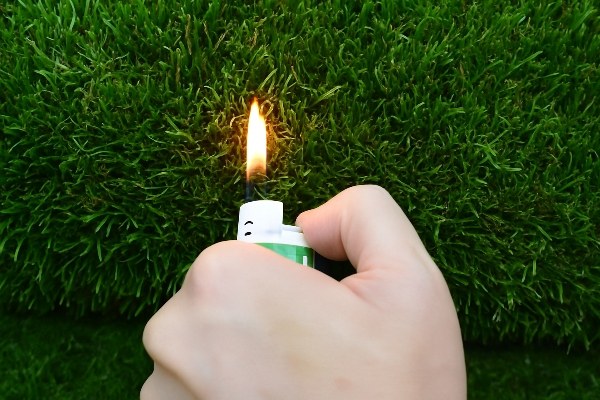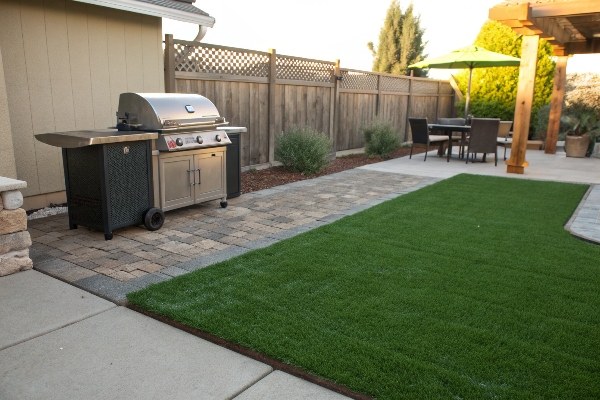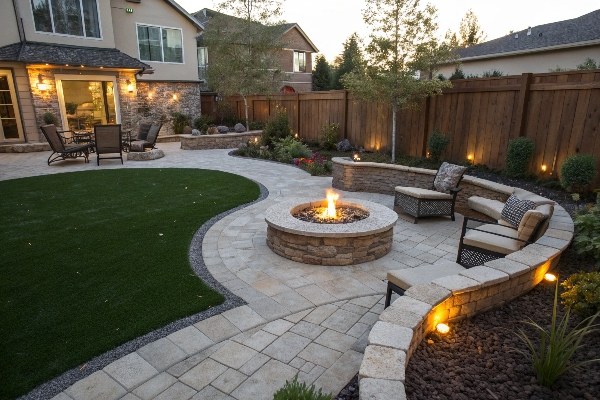Are you worried that a stray spark or ember could set your artificial lawn on fire? This fear can make you question the safety of your beautiful and valuable new surface.
The short answer is no, modern artificial turf does not catch fire and spread flames. High-quality turf is made with flame-retardant materials. It will melt when exposed to extreme heat or flame, but it will not ignite and burn like dry grass. The fire self-extinguishes.

I have worked in the artificial turf industry for a long time. So, I get this question from clients quite often, especially from business owners like you who are responsible for project safety and quality. It’s a very important question. You need to know exactly how the material performs to ensure the safety of your clients and the longevity of your installation. Let me break down the details for you. Understanding how it works will give you and your customers complete peace of mind.
Is artificial turf a fire hazard?
Do you need to prove to your clients that an artificial grass installation is safe? You might lose a project if you cannot answer safety questions with confidence.
No, quality artificial turf is not considered a fire hazard1. It is manufactured to meet safety standards. The materials contain additives that stop it from burning. When a flame is removed, the grass stops melting and any flame goes out. This prevents a fire from spreading.

In my experience as an engineer, the way turf reacts to fire is a key safety feature. It’s designed to protect people and property. Let’s look deeper into how this works. The key is in the manufacturing process. We add special flame-retardant ingredients2 directly into the plastic polymers before they are extruded into grass fibers. These aren’t just a coating; they are part of the material itself.
How it resists fire
When a flame touches the turf, the flame retardants activate. They work in two ways. First, they release tiny amounts of water vapor that help to cool the material at the point of contact. Second, they release gases that interfere with the chemical reaction of burning. This combination starves the potential fire of the heat and oxygen it needs to grow. The result is that the turf melts locally but does not catch fire and spread.
Melting is not burning
The melting point of the polyethylene used for turf is around 175 degrees Celsius (347 degrees Fahrenheit). This is hot, but much lower than temperatures that would cause other materials to burn. When turf melts, the fibers curl and fuse together into a hard, black patch. The damage is permanent and looks bad, but it stays in one place. It doesn’t produce flaming droplets that could spread the fire to other areas. This is a critical difference compared to something like a dry natural lawn, which would burn and spread fire very quickly.
| Material | Reaction to a Small Flame Source | Spread Risk |
|---|---|---|
| Dry Natural Grass | Ignites quickly, flame grows | Very High |
| Artificial Turf | Melts locally, self-extinguishes | Very Low |
| Wood Decking | Can smolder and eventually ignite | Medium to High |
| Concrete Patio | No reaction, may discolor | None |
Can you put a barbecue on artificial grass?
You want to enjoy a barbecue without ruining your lawn. A single mistake with a hot grill could create a permanent melted spot on your beautiful, expensive turf installation.
No, you should never put a barbecue directly on artificial grass. The heat from the grill, along with falling sparks, embers, or hot grease, will easily melt the synthetic fibers. This will cause irreversible damage and create an ugly, melted patch on your lawn.

I have seen clients make this expensive mistake. A perfect new lawn was damaged during the first weekend get-together. Repairing a melted section is difficult and can be costly, as you often need to replace a whole section to make it look right. The best solution is to plan ahead and take simple precautions.
Risk factors of grilling near turf
The main danger is heat. A charcoal or gas grill can generate intense heat, not just from the fire itself but also from the metal body of the grill. This radiant heat alone can be enough to exceed the turf’s melting point, even if the grill isn’t directly touching it. Embers and hot grease are also a major problem.
A single hot coal falling from a charcoal grill will instantly melt a hole in the turf.
Hot grease that splatters from cooking food can do the same thing.
These small spots of damage add up and ruin the look of the lawn.
How to grill safely
The only way to grill safely is to create physical separation and use protective barriers. Your barbecue station needs a dedicated, non-flammable surface. This is a best practice I always recommend to my clients who are designing outdoor living spaces.
| Do’s | Don’ts |
|---|---|
| ✅ Place the grill on a hard, level surface like a patio, concrete slab, or paving stones. | ❌ Do not place the grill directly on the artificial grass. |
| ✅ Keep the grill several feet away from the edge of the turf. | ❌ Do not let any part of the hot grill hang over the turf. |
| ✅ Use a high-quality, fire-resistant grill mat under the barbecue as an extra layer of protection. | ❌ Do not assume a regular mat or piece of wood is safe. |
| ✅ Keep a bucket of sand or a fire extinguisher nearby for emergencies. | ❌ Do not leave the grill unattended, especially with children or pets around. |
Can you put a firepit on artificial grass?
A cozy firepit sounds like a great garden feature. But putting it in the wrong place is a guaranteed way to destroy a large area of your artificial turf investment.
Absolutely not. You must never place any type of firepit directly on artificial grass. The intense, prolonged heat from a firepit will cause massive melting and can even damage the sub-base materials underneath the turf. This is a major safety risk and will cause severe damage.

A firepit is a far greater risk to artificial turf than a barbecue. A grill produces heat for a short time and is usually raised off the ground. A firepit, on the other hand, creates intense, sustained heat very close to the ground for hours. The radiant heat from a firepit affects a much wider area. Sparks and embers from wood-burning pits are also a huge risk.
Designing a safe firepit zone
For any projects that include a firepit, you must plan for a designated non-flammable zone. This isn’t just a suggestion; it’s a safety requirement.
- Build a Hardscape Base: The firepit must sit on a surface made of non-combustible materials. Good options include concrete pavers, natural stone, brick, or a poured concrete patio.
- Create a Clearance Area: The non-flammable surface should extend several feet out from all sides of the firepit. For a wood-burning pit, I recommend at least 3-5 feet (or about 1-1.5 meters) of clearance to catch any stray sparks.
- Consider Built-in Pits: For a truly professional and safe installation, building a permanent stone or brick firepit is the best option. This clearly defines the fire zone and adds value to the property.
Choosing the right firepit
Different types of firepits come with different levels of risk. You should advise your clients based on their specific needs and safety concerns.
| Firepit Type | Heat Source | Risk Level for Turf | Safety Notes |
|---|---|---|---|
| Wood-Burning | Burning Wood | High | Produces sparks and embers. Requires the largest clearance area and constant supervision. Must be on a proper hardscape base. |
| Propane/Gas | Controlled Flame | Medium | No sparks, but produces intense, direct heat. Still requires a non-flammable base. Radiant heat can still damage nearby turf. |
Always think about safety first. A melted lawn is a failed project. By building a proper, safe area for firepits, you protect your client’s investment and build your reputation for quality work.
Conclusion
Artificial turf is fire-resistant, not fireproof. It is designed to melt instead of burn, preventing the spread of fire. Always keep hot items like grills and firepits on safe surfaces.
_画板-1.png)
_画板-1.png)